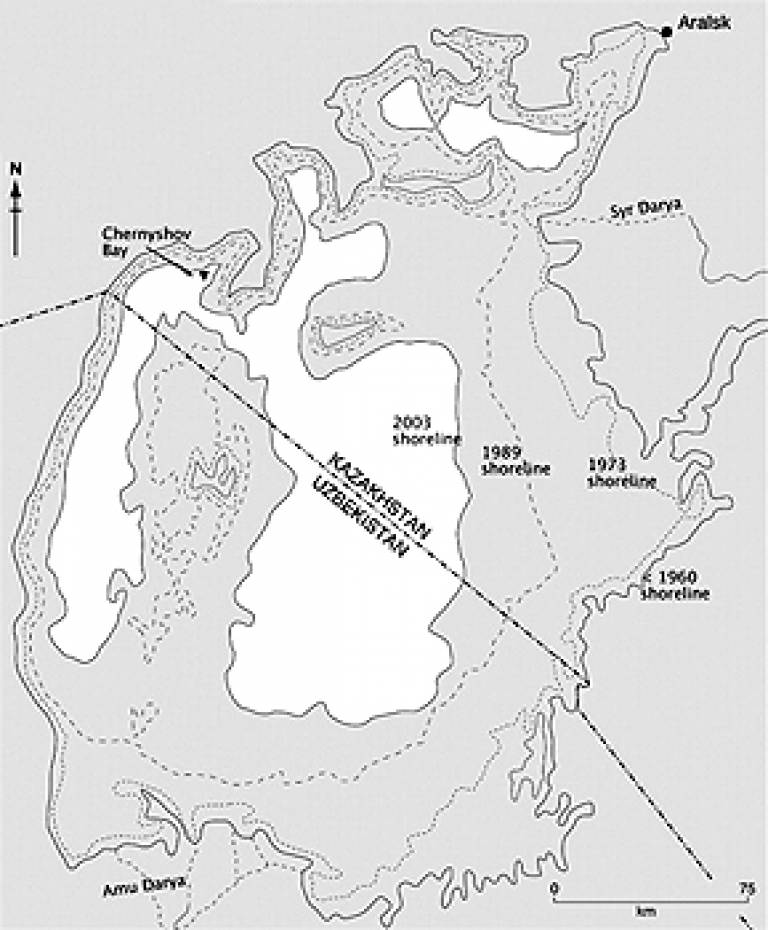Aral Sea shrinkage caused by humans
16 April 2007
The Aral Sea is drying out so rapidly that it has shrunk by two-thirds in less than fifty years, leaving two separate lakes where the world's fourth largest lake once was.
 But research published by UCL scientists shows that humans, including Genghis Khan and the White Huns, have affected the lake's fortunes for centuries.
But research published by UCL scientists shows that humans, including Genghis Khan and the White Huns, have affected the lake's fortunes for centuries.
Dr Patrick Austin and Dr Anson Mackay (UCL Environmental Change Research Centre) are authors of a paper appearing in this month's 'Quaternary Research' that describes how they deduced changes in the Central Asian lake by investigating changes in fossils and the chemical make-up of the water, along with colleagues from the Kazan State University and the University of Nottingham.
By analysing diatoms - microscopic algae covered in a glass-like shell - from an 11 metre core taken from the western area of the Aral Sea just inside the Kazakhstan border, the team discovered that in addition to the present regression, the lake also shrank severely at around 400 AD and again from 1195-1355 AD.
The current regression is largely due to the diversion of the Amu Darya and Syr Darya rivers away from the sea, one of the irrigation strategies of the former Soviet Union that has led to the loss of 90 per cent of its fish species and over 250 species of plankton.
The Soviets were not the first to meddle with the direction of the rivers feeding the lake, however. In the fifth century, there was a natural arid period in the region and lake levels were low as water-carrying cyclones failed to reach the Eastern Mediterranean, but this situation was compounded by the White Huns. As they swept west, it is believed they destroyed settlements along the Amu Darya river, diverting it away from the Aral Sea and towards Lake Sarykamysh to the southwest. The discovery of freshwater algae in the relevant sample from beneath the seabed indicates that the lake was restored to its former level in less than a decade after the Amu Darya started to flow back into the Aral.
Similar human interference exacerbated the dry conditions prevalent during the second severe dry period, during the twelfth to fourteenth centuries. While the failure of water-carrying cyclones to reach inland was again a likely factor, Genghis Khan's destruction of irrigation facilities and flooding of the city of Urgench (in modern southern Uzbekistan) again resulted in water being diverted towards Lake Sarykamysh, leaving the Aral Sea high and dry. It was this ruthless episode that heralded the start of the Mongol conquest of the Islamic States and gave the Mongols their reputation for bloodshed.
While some experts point to increased aridity across Central Asia as a factor in the present low levels of the Aral Sea, according to Dr Austin and Dr Mackay, the severity of the current shrinkage is unquestionably due to human interaction with the lake. Furthermore, their team's findings show that this regression is far from being a unique event, as humans have had a long-standing and detrimental relationship with the lake.
Image: The Aral Sea has shrunk by two-thirds since 1960
To find out more about the changing face of the Aral Sea, follow the links at the bottom of this article.
 Close
Close

